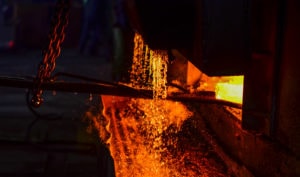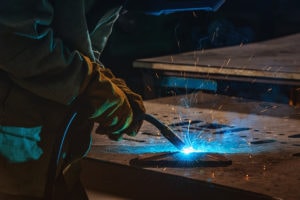Intro
Heat-treating a piece of metal can result in a range of different benefits. A lot of people will use heat-treated metals to improve their operation and gain an advantage over their competitors. If you want to make the most out of your metal parts, this is a good place to start.
In this article, we’ll describe how heat-treating works, and some of the major benefits of heat-treating metal before machining it.
What Is Heat Treating?
Heat treating is the process of getting metal really hot, then controlling how it cools down. This process changes the atomic structure of the metal being used, and it can result in completely different material properties.

There are a number of different forms of heat treatment that you can do to a metal. Each form will target a specific property of the metal to change, and each one serves a unique purpose.
One heat treatment process is great at making a part stronger while another will make it easier to machine on a CNC mill.
Heat treatment can be done before or after machining a part. In this guide, we’ll talk specifically about heat-treating the metal before machining, not heat-treating the finished part.
Benefits of Heat-Treating Metal
Heat-treating metal before it gets machined can make your parts perform better. Here are some of the benefits of this process.
Improve its Machinability
A machine shop might quickly heat treat the metal that they receive to make it easier to work with. If the metal was previously work hardened or cold rolled by the manufacturer, then the metal can be difficult to work with.
It might require special cutting tools, different machining speeds, and extra precautions while working with it. To save time and money while running the CNC machine, heat treatment will get rid of internal stresses in the material. The resulting part will be softer and easier to work with.
However, this doesn’t mean that the final part will be soft to the touch. It will still feel and act like metal, and it will be much harder than a soft rubber, for instance. The difference isn’t noticeable by touching the part, but it’s very noticeable when running a CNC machine.
Optimize Durability
On the opposite end of the spectrum, heat treatment can also be used to optimize a part’s durability. Durability refers to how long a part can be used before it wears down and becomes unusable.
To make a more durable part, the heat treatment process focuses on hardening the part. This can be done at a surface level by “case hardening” the part, or it can go all the way through the metal through “traditional hardening”.
Harder metals can take more damage before they fail. If the part is going into an aggressive environment, then hardening should be considered.
Improve Wear Resistance
In addition to being more durable, a hardening process can also prevent wear on your part. In the field, wear can happen whenever another object comes in contact with this metal part.
Over time, wear can lead to a part’s downfall. Wear will make your part thinner and can deform it.
Make Tougher and Stronger Parts
In other cases, you can focus on toughness and strength through heat treatment. A stronger part can support more weight and a tougher part can take a bigger impact without deforming.
For structural parts or anything supporting weight, heat treatment is a must-have.
There are a few different ways to make a part tougher through post-processing. Heat treatment will change the metal on an atomic scale, and it’s a great place to start.
Reduce Magnetic Properties
In certain applications, metals can become magnetic during fabrication. Specifically, 316 stainless steel can become magnetic when you work-harden the part (a processing step that makes the part more wear-resistant).
If you can’t have magnetic parts in your application, then you’ll need to undo this magnetization. The good news is that heat treatment can reset the magnetic properties of a metal.
The same heat treatment will also prevent the metal from becoming re-magnetized in the future. That means that you should go through this step if you have metals getting installed near magnets in your operation.
Even a weak magnetic field can magnetize some metals if they’re in the vicinity for enough time.
Conclusion
Heat-treating metal before machining your part has a lot of benefits. It can make your parts stronger, more durable, easier to machine, and resistant to magnetism. If you want to learn more about heat treatment or you want to order some heat-treated metal parts, you can contact our team at Rapid Axis. We are a full-service machine shop that can deliver high-quality heat-treated metal parts and much more.
